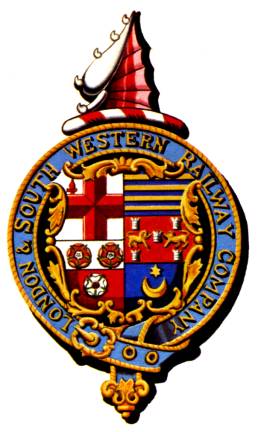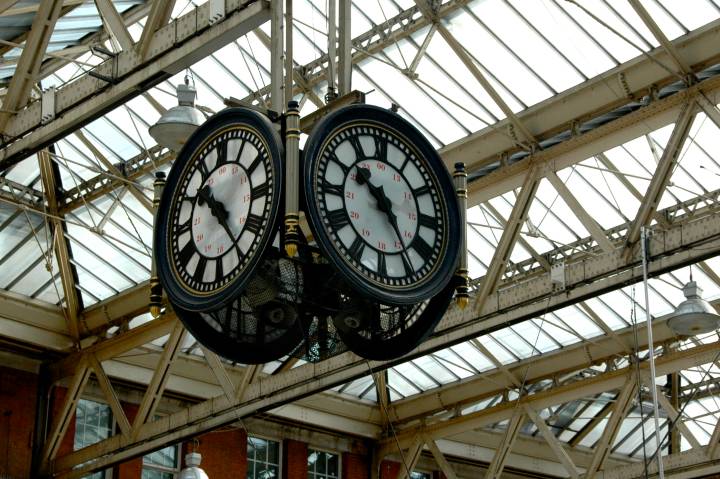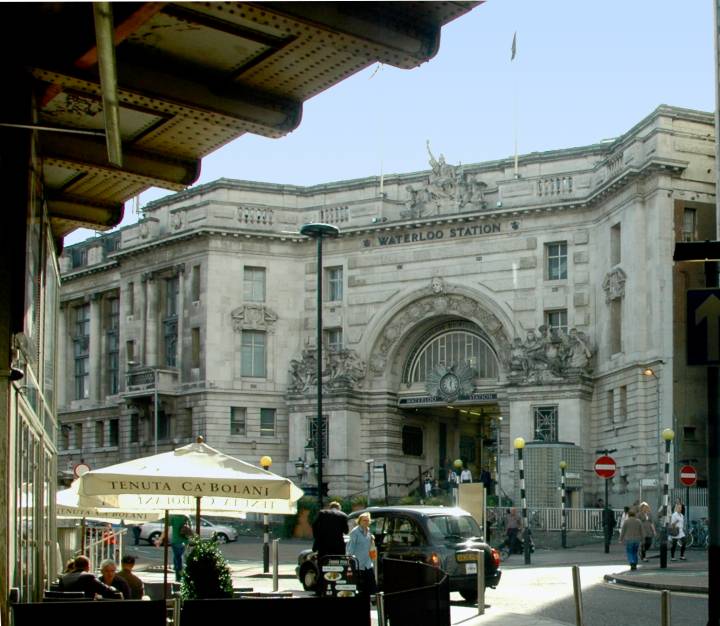[The following passages are excerpted from Pattinson's late-nineteenth-century book on British passenger railways. — George P. Landow.]
General Description of the Line

With the exception of the North-Eastern this line is, perhaps, less competitive than any other. It certainly has some little rivalry with the Brighton Company at Portsmouth and the Great Western at Exeter and Weymouth. But, with these exceptions, the district is peculiarly its own. Its main line extends very directly from London to Exeter through Basingstoke, Salisbury and Yeovil Junction. Thence to Plymouth vid Okehampton is somewhat roundabout, crossing the moorlands, while the Great Western, which is also a circuitous route, keeps to the sea-coast. At Yeoford Junction on the Plymouth line, is a branch to the well-known walering-place of Ilfracombe. An important main artery of the system leaves the Exeter line at Woking and travels via Guildford, Petersfield and Havant to Portsmouth for the Isle of Wight. Then again, from Basingstoke the Southampton line leaves the main route and, passing through Winchester and Southampton West, divides at Brockenhurst, one line going south-west to Bournemouth, and the other west and then south to Swanage and Weymouth. From Southampton there are frequent boat services to the Channel Islands, as well as to the French ports of Havre, Honfleur, Cherbourg and St. Male. Besides these three principal sections, we have numerous other branches of more length than importance, many of them forming lines almost parallel to those already described. But perhaps the most productive area from which the company gather their passenger receipts is that surrounding the metropolis in a south-westerly direction. Here their lines form a very intricate network, while further west we find them in competition at Windsor and Reading, with the Great Western. Again, at Aldershot and Brookwood (for Bisley) a considerable Volunteer traffic is dealt with. The total length of the system is nearly 800 miles, and the company are joint owners with the Midland of the Somerset and Dorset Joint Railway, which connects Bath with the favourite and rapidly increasing wateringplace of Bournemouth.
Travelling Facilities
(a) Services between Chief Towns. It is greatly to the credit of the South-Western that, in spite of demoralising surroundings, all their trains carry third-class passengers. We are thus relieved of the task of eliminating trains carrying first- and secondclass passengers only, as was the case on the South-Eastern, London, Chatham and Dover, and London, Brighton and South Coast railways. Beyond this commendation, however, we cannot very highly praise the services given by this system, except, perhaps, those to Exeter and Bournemouth. Southampton and Salisbury undoubtedly have good trains, but they are too few in number, while Portsmouth would appear to have been almost entirely neglected. We here find ourselves returning from the pleasant frequency of expresses, which forms so attractive a feature in the Great Eastern programme, to the more usual style in vogue on the lines south of the Thames, of running one or two good trains and no more, to the most important points. Thus, the 11 a.m. and 3.0 p.m. trains to Exeter are admirable specimens; but the unfortunate traveller who is unable to arrange his journey at the above times must rest contented with the slower and more sedate pace of the other South-Western trains. This state of things will doubtless in time be remedied. Without looking for the dispatch and frequency common to the northern lines, with their more important centres of traffic, the South-Western might still add a few more smart trains to their time-tables.
The system has, however, of late years been steadily developing into a first-class line. The services to Exeter have been quickened up, and this acceleration has, of course, benefited intermediate towns. The new line to Bournemouth has, in fact, revolutionised the services between that place and London; and Southampton West is now, at length, by means of these very fast trains, brought within a reasonable time of the metropolis.
Another detail in which the South-Western has noticeably improved is that of punctuality. Some of their trains are very sharply timed, and it is extremely creditable that they should run as they now do, seeing, moreover, that only a few years back the line had acquired a most unenviable reputation for unpunctuality. In the Parliamentary Return of Punctuality which, by the way, gives merely an approximate idea of the state of affairs the Southwestern occupies a good position. So many delays occurred in the past over the last few miles into London that we may now reasonably hope that, with the advantage of the two additional lines of rail, much of the former lateness will disappear.

Southwest England from O. S. Nock. The Pocket Encylopaedia of British Steam Locomotives. (End paper inside backcover).
On the country branches of the system there is nothing remarkable to record as far as the train-services are concerned. They are carried on at the usual 20-25 miles an hour (including stops) which is characteristic of English local trains. Near London, however, the company vie with the Great Eastern in the magnitude of their suburban traffic This is worked at a tolerable speed, and there is little fault to find, either on the score of frequency of service or punctuality. The company's territory includes most of the riverside resorts, and the population abounds in season-ticket holders. There is also a connection with Epsom, and on the Derby Day the resources of the line are taxed to the utmost to cope with the enormous facing traffic.
(b) Rolling Stock and General Accommodation. The accommodation given, though at present only moderate, is rapidly improving. Making every allowance for the very large number of small and antiquated carriages running on the suburban and branch lines, we should still be inclined to rank the South-Western carriage stock as, on the whole, superior to that of any of the three other southern lines. With newly-infused energy, for some time past the company have been building most roomy and comfortable vehicles of all classes. The seconds and thirds are excellent, and the Northwestern itself might be proud to own some of the firsts, with their lavatory conveniences and tasteful decoration and upholstery. Besides these comfortable compartments, there are now on the Bournemouth fast expresses some handsome Pullman cars, representing, one would suppose, the ultimatum in railway-carriage construction and decoration. That such is the opinion of the directors may be gathered from the imposition of an additional charge, over and above the first-class fare, on those travelHng in them.
Much, nevertheless, remains to be done on the South-Western as regards rolling stock. The local and branch line stock is still much more frequently seen than the newer vehicles. The present management has of late shown so much enterprise in various ways, that we are justified in assuming that this state of affairs will very soon be remedied. In other departments of working there is much to praise. Almost all the passenger rolling stock has been for some time fitted with the Automatic Vacuum brake, and the station accommodation is generally of an excellent character.
Locomotives, speed, gradients, and actual performance


Two of the The London and South-Western Railway locomotives: Left: 580, a 2-4-0 express passenger engine. Designer: W. Dean. Right: Jubilee Class 0-4-2 engine (1887). [Click on images to enlarge them.]
(a) Speed. On the London and South-Western Railway the time-table speed is curiously unequal, and we find many instances of faster work on steep gradients than on the more level sections. Thus, east of Salisbury, speed rarely exceeds 45 miles an hour, and the best instances are exceptional, and are, perhaps, those of the up and down Bournemouth expresses, which are timed, over some parts of their journey, at from 48 to 50, and two of which make excellent runs from Southampton to Woking and Vauxhall respectively in 68 and 94 minutes (54 J and 77 j miles). On the hard grades west of Salisbury we have much better work, on the average. The Exeter expresses furnish us with such fine performances as 66 minutes from Sherborne to Exeter (53^ miles), and 61 and 62 minutes between Exeter and Yeovil (49 miles). Considering the heavy gradients this is, indeed, admirable work. On the other parts of the London and South-Western system no speeds of importance are attained. This is generally due to steep gradients, and to the absence of competition.
(b) Gradients. The fast expresses to Exeter, especially the 3.0 p.m. down, are really such fine examples of locomotive work that we purpose giving under this head more detailed information than has been done when treating of the other southern lines. This particular train (the 3.0 p.m.) not only starts well on its west-bound journey, but improves as it gets further on its course, until at last its performance over the heavy banks near Chard and Honiton quite entitles it to rank with the North-Western and Midland displays on their heavy roads south of Carlisle. It will, therefore, be necessary to examine the gradients closely, so as properly to estimate the value of the performance.



Left to right: (a) Riveted beams, capitals, and horizontal trusses, Waterloo Station. London. 1869, 1878, 1885; rebuilt between 1900 and 1922 (b) Clock, Waterloo Station. (c) Exterior. 1900-22. [Click on these images for larger pictures.]
From Waterloo the South-Western rises very gently, with frequent undulations, for twenty miles. This is followed by eleven miles of 1 in 300 up, five miles level and six miles easy rise. Three miles gentle fall are followed by about nine miles of varying rising grades, mostly about 1 in 300. This takes us 54 miles from London. The road now becomes stiffer, but still undulates until the 62nd milepost. Then follow three and a half miles of 1 in 178 down, two and a half miles of 1 in 220 up and 1 in 330 down, one and a half miles of 1 in 264 up, and three miles of 1 in 165 up. Thence to Salisbury, 1 1 miles, is a descent, of which the steepest part is from post 75 to 81, being 1 in 245, 140, and 169. The 3.0 p.m. down gets 110 minutes for the 83. miles (including two stops). This is very excellent, but not so good as what follows.
From Salisbury to Exeter the gradients are very steep, and are massed together in such a way as to seriously diminish speed. . . . With the exception of the Bournemouth expresses, which run exceedingly well between London and Southampton West, there is not much speed on any of these sections. . .
(c) Locomotives. To perform the work thus briefly sketched out, the company have some excellent locomotives. Most of them have been constructed from the designs of the well-known Locomotive Superintendent, Mr. W. Adams. A list of some of the newer types, with dimensions as here given, will be found useful for purposes of comparison. The heavy express and other new stock is painted a bright green, picked out with black, in strong contrast with the dark-brown " Vivids," and other well-known names of Mr. Beattie's design. A large proportion, as may be supposed, consists of very serviceable tank engines. These, and, indeed, nearly all the locomotives for passenger traffic (except two classes of tanks, and a powerful type of mixed traffic engine lately built), have the combination of a leading bogie and outside cylinders. For passenger trains, indeed, the outside cylinder would seem to have been the rule on this line almost from the earliest date. The goods engines, on the contrary, are furnished with inside cylinders. Many old specimens still doing duty by the side of the much more powerful constructions of recent date serve to indicate the vast strides made by the company in this direction. The coal consumption for all classes is about 27 lbs. per mile. This low figure is, of course, explained by the fact that passenger traffic bears a large proportion to the total. The brake used is the Automatic Vacuum. We now present the dimensions of the various recent classes of passenger engines. Quite lately, a new express type, closely approximating to his 19 by 26 engines described below, but with 6 ft. 7 in. wheels, has been built by Mr. Adams.
(d) Actual Performances. For the best of these we must look to the Bournemouth and Exeter expresses. The former are very sharply timed over a moderately hard course, and generally manage to run within their time. The long uphill piece from Southampton (17 miles averaging 1 in 240) is run over by the best up express in very creditable style. Of the Exeter expresses we have already said something. The 3.0 p.m. down makes good runs between its stopping points right through from London, and the other trains have also very quickly-limed pieces here and there. Perhaps the most creditable timing is the run from Exeter to Yeovil Junction in 62 minutes (12.45 p.m. and 6.0 p.m. up). This is at the rate of about 47 miles an hour over an exceedingly difficult course much harder than the reverse way. We append herewith a run by the 6 p.m., with a load of 14 coaches. It takes rank, we think, with some of the best performances of other lines. [75-85]
Related Material
- The Select Committee of 1844 on Railways (Parliamentary Train Act' of 1844)
- Railway Mania
- “For Godsake be done with railways and shares!” — the 1840s Railway Panic
- Hudson the Railway King
- Railways and Victorian Literature — An Introduction
Bibliography
Pattinson, J. Peabody. British Railways: Their Passenger Service, Rolling Stock, Locomotives, Gradients, and Express Speeds. London: Cassell, 1893. Internet Archive version of a copy in the Stanford University library. Web. 26 January 2013.
Last modified 27 January 2013